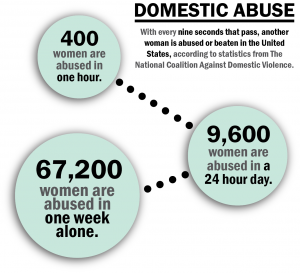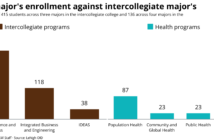
Designed by Kelly McCoy
Every nine seconds, another woman is abused or beaten in the United States, according to statistics from The National Coalition Against Domestic Violence. That means 400 women are abused in one hour, 9,600 are abused in a 24-hour day and 67,200 in one week alone.
Emily Rieser, an outreach educator for Crime Victims Council of Lehigh Valley, a non-profit organization that offers resources and support to abuse victims in the area, says even though people are aware of the domestic abuse issues nationally, they want to deny its presence in their hometown.
“Domestic violence, like sexual violence, is one of those things where people know it exists, they know that it’s bad, and that it shouldn’t happen, but it’s one of those things where a lot of times, people say, ‘Yeah but not here, that doesn’t happen here,’” Rieser said.
Rieser’s daily activities are proof that domestic violence is a very real issue in Lehigh Valley. Most of her days are spent helping victims of domestic abuse trying to escape their situations.
Crime Victims Council, along with other organizations of the Lehigh Valley and a network of shelters in neighboring counties, work together to find these victims a place to run when they feel trapped or need the resources to leave a dangerous situation of an abusive partner.
According to Rieser, most of the victims of domestic abuse she deals with are women, and even with the efforts of these organizations, she says the process of ending a violent relationship is not easy. From the moment a victim begins the process she must do so carefully, this is made clear by the by the “exit quickly” buttons in the corner of most domestic violence hotline websites, in case the abuser comes into vision of the computer.
Rieser said the moment a victim decides to leave their partner is often the most dangerous, and at times, fatal. This is why she stresses the first step to escaping is finding out as much information as possible about the situation and creating a safety plan accordingly.
Domestic abuse cases vary based on the financial state and age of the partners involved in it. Rieser said because of this, the safety plan for each victim would be different. For some women, it will be setting up a safety word with a family member or friend to come help them if things are getting heated. For another, it might be immediately relocating her to a shelter.
Often, taking the woman away from the situation doesn’t assure that she won’t voluntarily go back. On average, Rieser will see a woman leave and return to her abuser eight times before leaving for good.
Jackie L. Gower, a licensed professional counselor at Women’s Solution in North Side Bethlehem, has worked with many women after they had left their abusive relationships. She said many women leave the first few times only because they know society is expecting them to. A lot of the time, she said, the victim does not want to think their significant other is a bad person, but even more, the victim doesn’t want to have to think about what being in this type of relationship might say about themselves.
“Nobody wants to look at somebody they love and think there is something bad about them, even if they are being a jerk, and even if they are being mean and abusive,” Gower said. “We all have this tiny little narcissistic side to our personality and a lot of times it will come back to, ‘What does it say about me? It doesn’t speak very highly of me if I’m choosing somebody who is a bad person, someone who is abusive.’”
This is why Gower emphasizes that after leaving a violent relationship, it takes a lot of time and conscious effort to get to the deep insecurities that might have landed these women in the situation in the first place.
Gower said it’s not about putting the blame on the victim, but about helping them realize character traits and red flags that they might have missed within a relationship. The ultimate goal is to teach these women the skills and tactics to avoid finding themselves in another dangerous relationship, because often an abuser knows the type of woman to target to be able to have this power play.
Rebecca Stratton, a victim of domestic abuse and resident of Whitehall, said when her partner violently attacked her, she had been shocked. She had seen no warning signs or “red flags,” as Gower calls them. It wasn’t until she was out of the relationship for some time that Stratton was able to see that abuse comes in various forms and her partner had been abusing her financially quite some time before the physical abuse. Not only was he not working and constantly asking her for money, but he was also making her pay for the gas in her car that she never got to use.
“A lot of times these people who do become abusive, they know what to look for,” Gower said. “They look for people who might have a lower self esteem or people who have a lower sense of self because they are easier to manipulate and to control.”
Dr. Henry Gursky, a licensed psychologist in Pennsylvania has worked on domestic abuse cases in Lehigh Valley ranging from partner abuse stemming from drugs, to child abuse in satanic rituals. Despite the diversity of the cases, one of the things he has found over the years was abuse that abuse was being passed through generations.
“Most, if not all, of the perpetrators of abuse had been abused, and that became a resounding theme anytime I evaluated anyone,” Gursky said. “What I started to see was this unending cycle of abuse that would occur through generations.”
He also notes that domestic violence and dual diagnosis almost always go hand-in-hand. A history of mental illness, such as bipolar disorder or even post-traumatic stress disorder, is more likely to lead to violence if combined with other issues.
A person’s unresolved emotions, such as abandonment and rejection issues, may also be keeping them in a cycle of violence.
“When you’re felling helpless, you’ll cling to whoever, no matter how they treat you,” Gursky said.
Although the specific factors causing abusers to backlash violently towards those around them may change based on the person, more often than not abuse is not a tendency that a person is born with, but a habit they observe and inherit from life experiences.





Comment policy
Comments posted to The Brown and White website are reviewed by a moderator before being approved. Incendiary speech or harassing language, including comments targeted at individuals, may be deemed unacceptable and not published. Spam and other soliciting will also be declined.
The Brown and White also reserves the right to not publish entirely anonymous comments.